Strategies to Use Chatbots for Better Customer Experience

In today’s fast-paced digital world, businesses must prioritize seamless customer experience to stay competitive. Chatbots improve customer experience by enabling companies to handle queries efficiently while enhancing user satisfaction. Studies reveal that chatbots can resolve 90% of questions in under 11 messages, saving up to 30% on customer support costs.

Sobot’s Chatbot takes this innovation further by combining AI-driven insights with 24/7 availability. It empowers businesses to manage high query volumes, deliver personalized interactions, and optimize resources effortlessly. With Sobot, you can boost operational efficiency by 70% and improve customer engagement, as seen in OPPO’s 94% positive feedback rate after implementation.
The growing adoption of chatbots, projected to reach a market value of $46.64 billion by 2029, underscores their transformative potential. By integrating Sobot’s solution, you can redefine how you interact with customers and create lasting positive experiences.
How Chatbots Improve Customer Experience
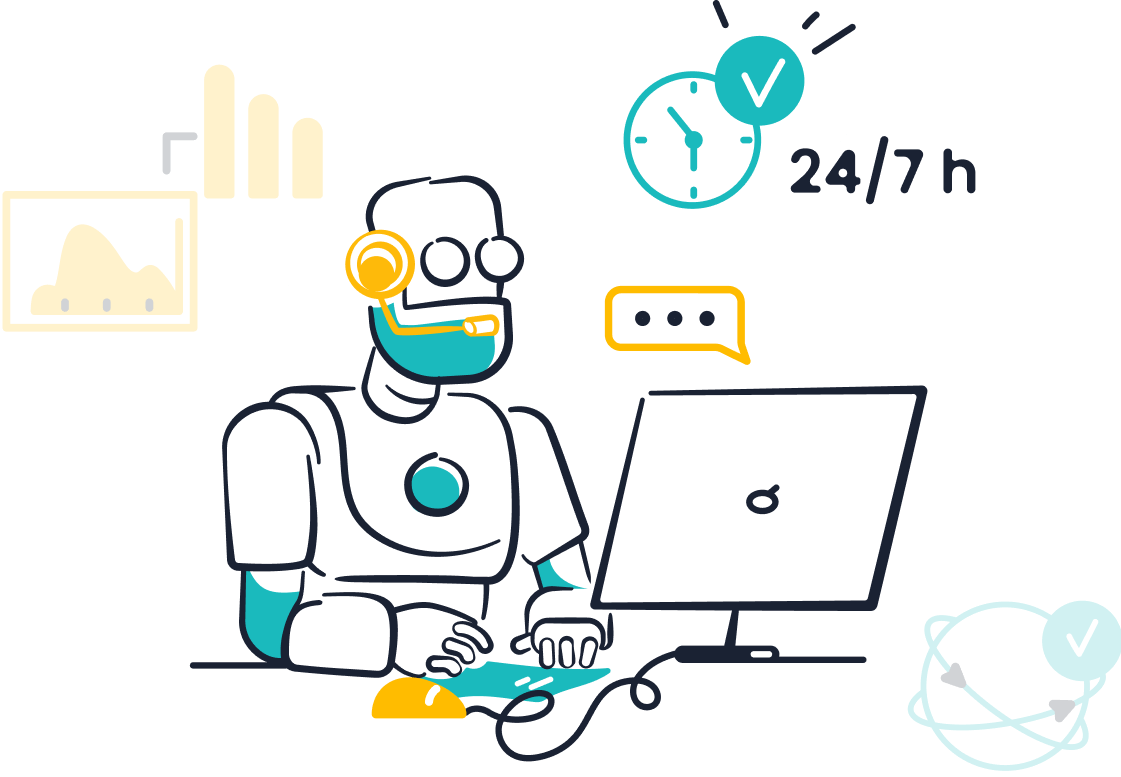
24/7 Availability for Instant Support
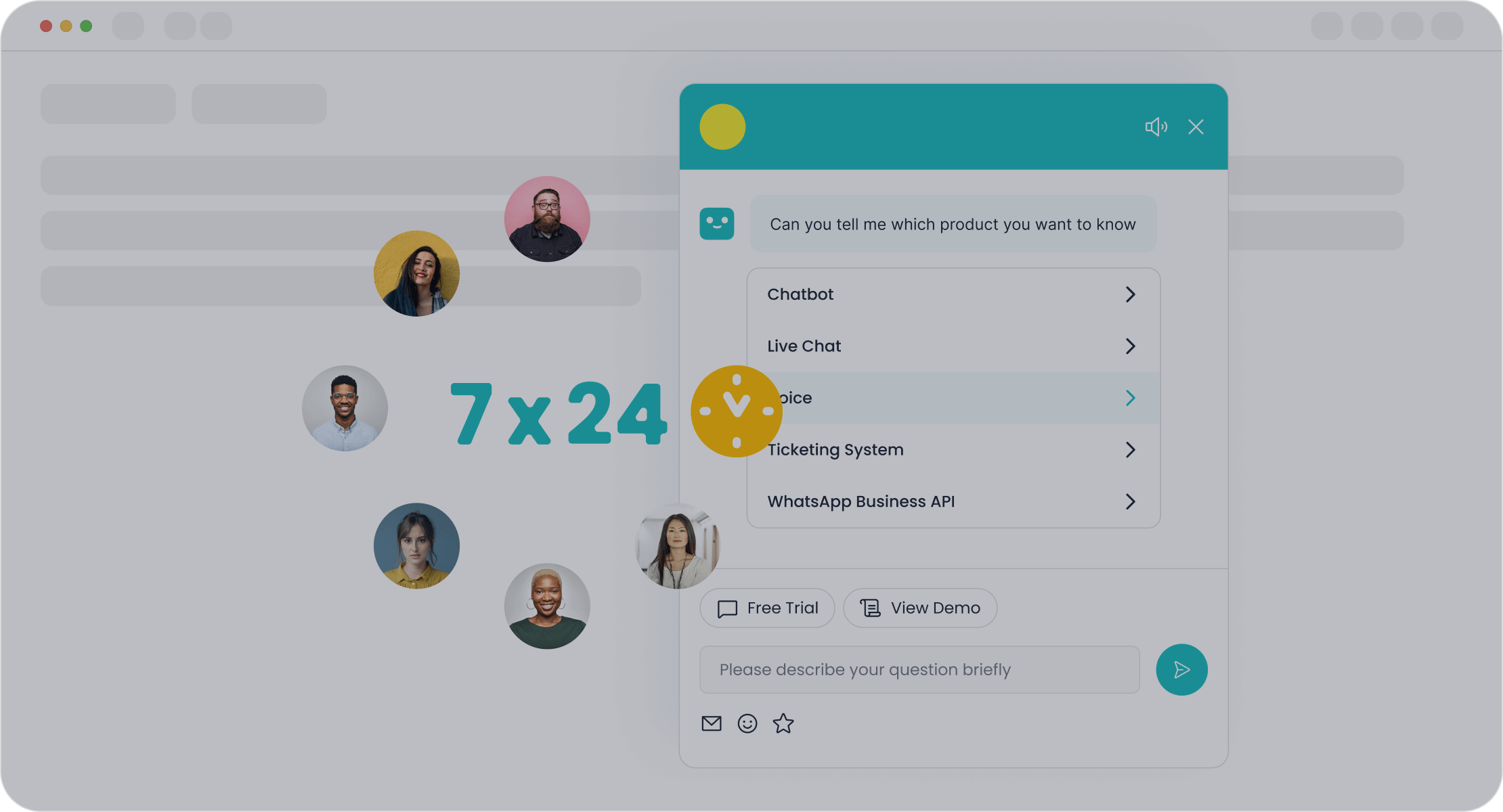
Customers expect immediate assistance, regardless of the time or day. Chatbots excel in providing 24/7 customer support, ensuring no query goes unanswered. Unlike human agents, chatbots operate round the clock, offering instant responses to customer inquiries. This availability reduces wait times and enhances customer satisfaction. For instance, Sobot’s AI-powered chatbot ensures uninterrupted service, handling queries even during peak hours or holidays.
By being available at all times, chatbots improve customer experience by addressing issues promptly. This capability not only boosts customer satisfaction scores but also builds trust and loyalty. Businesses that adopt 24/7 customer support through chatbots can significantly reduce response times, ensuring better response times for their customers.
Scalability to Handle High Query Volumes
Handling a surge in customer inquiries can overwhelm traditional customer service teams. Chatbots, however, scale effortlessly to manage high query volumes without compromising performance. For example, Sobot’s chatbot maintains a latency of under 10 seconds and 100% uptime during peak hours. It processes up to 30 requests per second, ensuring smooth operations even during busy periods.
| Metric | Value |
|---|---|
| Latency P99 | <10 seconds |
| Uptime | 100% during peak hours |
| Requests Per Second | 30 |
Additionally, Sobot’s chatbot supports future integrations with platforms like Shopify and Stripe, making it adaptable to growing business needs. Its ability to handle complex data ensures seamless customer interactions, even as query volumes increase. This scalability allows businesses to maintain consistent service quality, enhancing customer satisfaction and operational efficiency.
| Feature | Description |
|---|---|
| Future Integrations | Supports Shopify and Stripe |
| Data Complexity Handling | Scales with increased volume |
Cost-Efficiency and Resource Optimization
Chatbots offer a cost-effective solution for businesses aiming to optimize resources. By automating routine tasks, they reduce the need for additional human agents, cutting labor costs by up to 50%. Sobot’s chatbot, for instance, autonomously resolves 80% of FAQs, allowing human agents to focus on complex issues. This division of labor improves efficiency and reduces operational expenses.
| Metric | Value |
|---|---|
| Cost savings through chatbots | up to 30% of customer service costs |
| Savings on labor costs of a human employee | 100% |
| Cost reduction in customer service and sales through chatbot use | 20% |
| Increased efficiency in handling inquiries | 80% of FAQs can be answered independently |
| ROI within 2 years | 300% to 700% |
The financial benefits extend beyond cost savings. Chatbots also boost productivity by 70%, enabling businesses to achieve more with fewer resources. This optimization not only improves customer service but also enhances overall business performance. By investing in AI-driven solutions like Sobot’s chatbot, you can achieve a high return on investment while delivering exceptional customer experiences.
Personalization Through AI and Data Insights
Personalization has become a cornerstone of modern customer service. Customers expect tailored experiences that cater to their unique preferences and needs. Chatbots improve customer experience by leveraging AI and customer insights to deliver these personalized interactions. By analyzing data such as past purchases, browsing behavior, and preferences, chatbots can provide recommendations, resolve issues, and even predict customer needs.

For example, Sobot’s AI-powered chatbot uses advanced natural language processing (NLP) to understand customer intent and deliver relevant responses. This capability not only enhances customer satisfaction but also drives business outcomes. By 2025, 85% of customer interactions are expected to be managed without human agents, thanks to advancements in AI technologies like NLP.
The benefits of personalization extend beyond customer satisfaction. Businesses using AI-driven personalization report significant improvements:
| Benefit | Statistic/Impact |
|---|---|
| Increase in marketing effectiveness | 30% increase reported by companies |
| Growth in sales | 20% growth reported by companies |
| Customer satisfaction | 91% of consumers prefer relevant offers |
| Revenue growth | Up to 25% reported by some companies |
| Reduction in customer acquisition costs | Up to 50% reported by McKinsey research |
| Improvement in marketing ROI | 10–30% improvement reported |
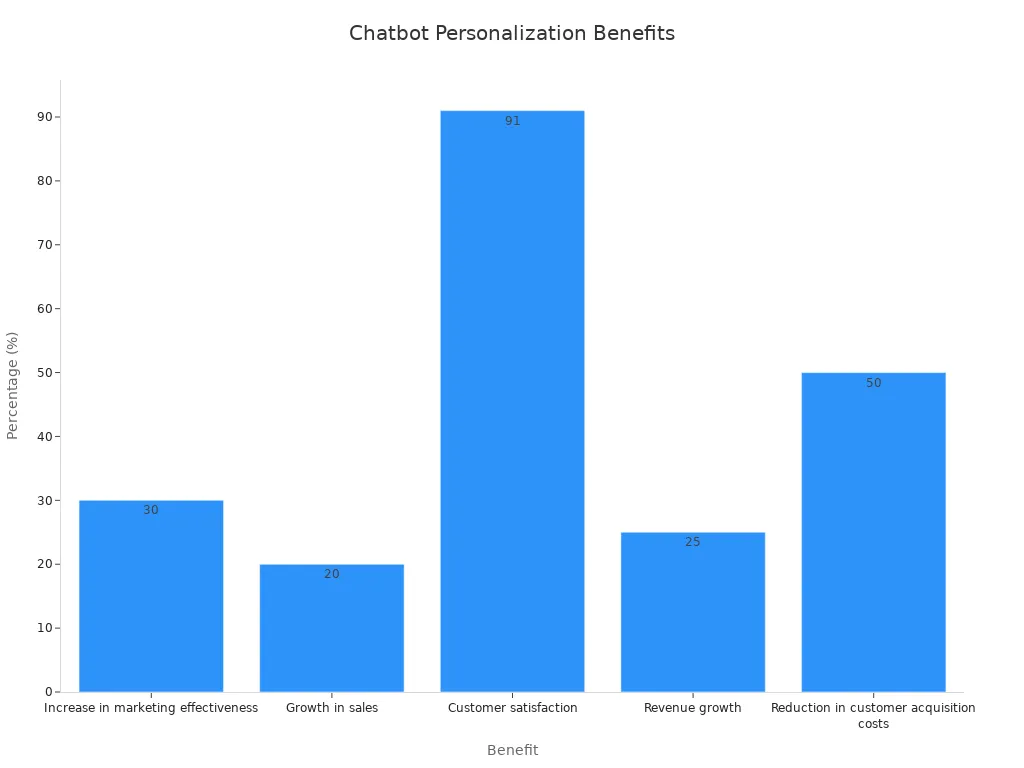
Sobot’s chatbot takes personalization further by integrating seamlessly with omnichannel platforms. This ensures customers receive consistent, personalized experiences across channels like WhatsApp, SMS, and live chat. By using AI to analyze customer insights, you can create meaningful interactions that boost customer satisfaction scores and loyalty.
Consistency in Customer Interactions Across Channels
Consistency plays a vital role in building trust and delivering a seamless customer experience. Customers often interact with businesses across multiple channels, including social media, email, and live chat. Maintaining the same level of quality and tone across these platforms ensures a cohesive experience.
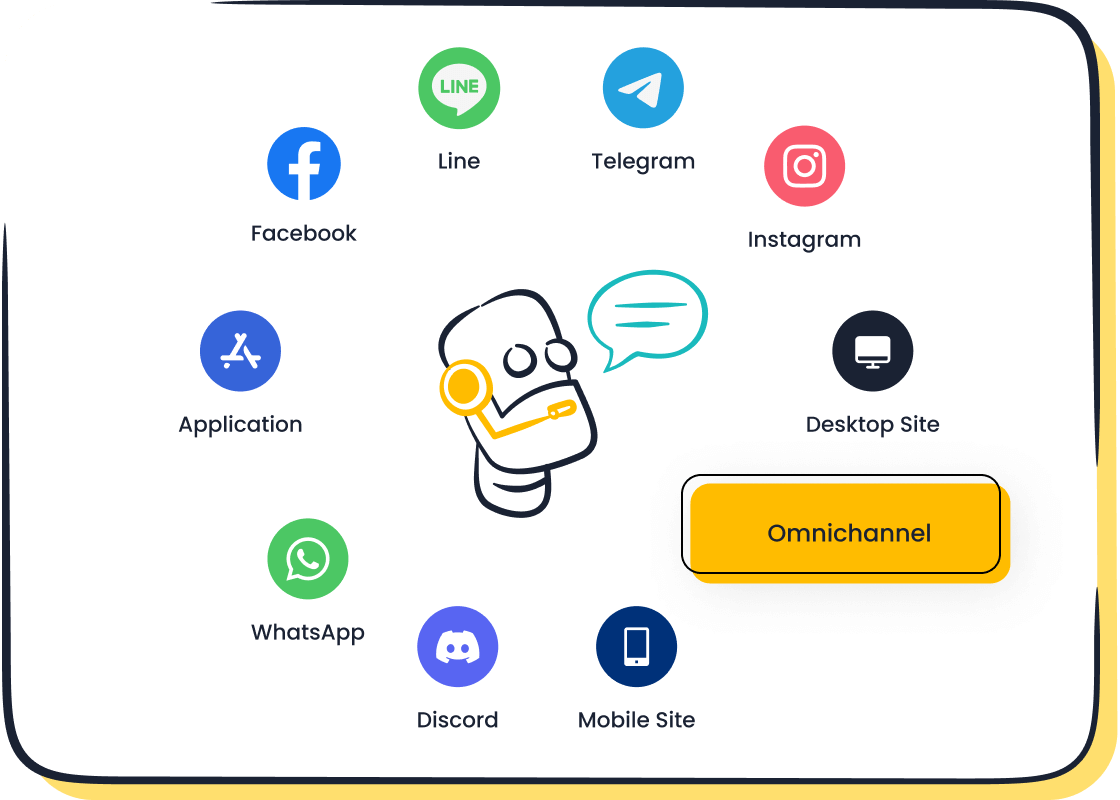
Customer service chatbots excel in providing consistent interactions. They follow predefined workflows and use centralized knowledge bases to deliver accurate responses, regardless of the channel. Sobot’s chatbot, for instance, integrates with various platforms to unify customer interactions. This ensures that whether a customer reaches out via WhatsApp or email, they receive the same high-quality support.
Interaction quality directly influences customer trust and satisfaction. Chatbots mimic human operators to enhance the perceived quality of interactions. This design ensures customers feel valued and understood, regardless of the medium. Key benefits of consistent interactions include:
- Building trust, which encourages repeat business.
- Enhancing customer satisfaction by reducing frustration caused by inconsistent responses.
- Improving operational efficiency by streamlining workflows across channels.
By adopting AI-powered chatbots like Sobot’s, you can ensure better response times and consistent service quality. This approach not only improves customer satisfaction but also strengthens your brand reputation.
Practical Use Cases of Chatbots in Customer Service
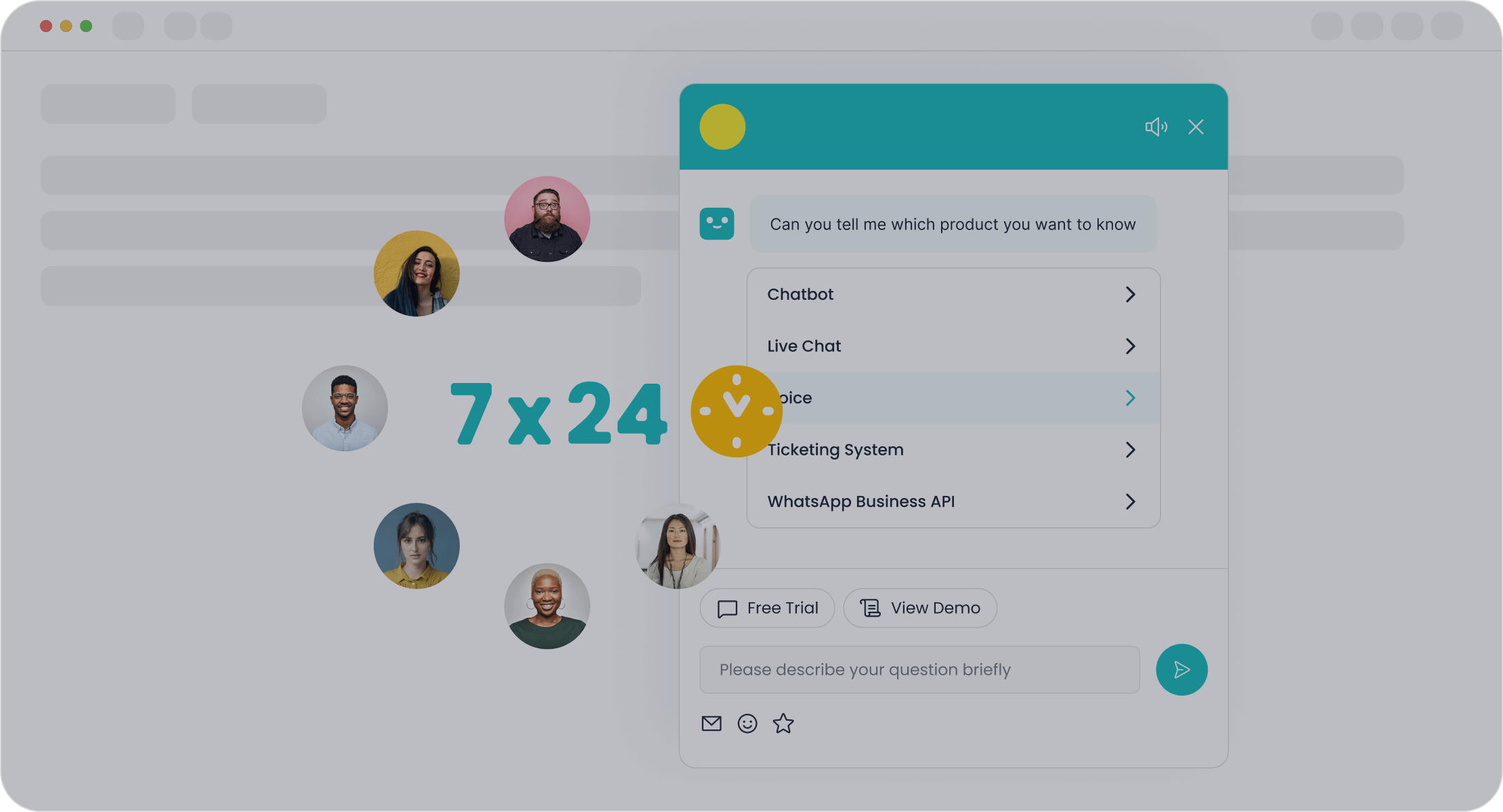
Automating FAQs and Routine Queries
Chatbots excel at handling repetitive tasks, making them ideal for automating FAQs and routine queries. By addressing common questions like store hours, return policies, or account issues, chatbots free up human agents to focus on more complex customer interactions. This automation significantly reduces wait times and improves productivity.
Consider a scenario where a customer wants to know the status of their package. Instead of waiting on hold, they interact with a chatbot that quickly accesses order information and provides real-time updates. This process satisfies the customer’s need for immediate information and frees up valuable agent time for more nuanced support cases.
Chatbots also operate 24/7, ensuring customers receive support whenever they need it. Unlike human agents, they don’t require breaks, which guarantees uninterrupted service. Studies show that 62% of consumers prefer using a chatbot for customer service over waiting for a human agent. Additionally, conversational AI reduces operational costs by automating repetitive tasks, allowing businesses to allocate resources more effectively.
Enhancing Order Tracking and Delivery Updates
Keeping customers informed about their orders is crucial for building trust and satisfaction. Chatbots simplify this process by providing real-time updates on order status, shipping details, and estimated delivery timelines. This transparency enhances the overall customer experience and reduces the need for manual inquiries.
For example, Sobot’s chatbot integrates seamlessly with e-commerce platforms to deliver instant updates. Customers can check their order status or track deliveries without navigating through multiple channels. This efficiency not only improves satisfaction but also reduces the workload on your support team. Retail businesses that implement chatbots for order tracking report fewer support inquiries and higher customer retention rates.
Providing Personalized Product Recommendations
Personalization is key to creating meaningful customer interactions. Chatbots leverage AI to analyze customer data, such as browsing history and purchase behavior, to offer tailored product recommendations. This approach not only enhances the shopping experience but also drives sales.
Sobot’s chatbot takes personalization to the next level by integrating with omnichannel platforms like WhatsApp and SMS. It uses advanced AI algorithms to understand customer preferences and deliver relevant suggestions. For instance, if a customer frequently purchases skincare products, the chatbot can recommend complementary items or notify them about upcoming sales. Businesses using AI-driven personalization report a 20% increase in sales and a 30% improvement in marketing effectiveness.
By adopting chatbots for personalized recommendations, you can create a more engaging shopping experience while boosting revenue. This strategy not only meets customer expectations but also strengthens brand loyalty.
Supporting Multilingual Customer Communication
In today’s globalized world, customers expect businesses to communicate in their preferred language. Chatbots equipped with multilingual capabilities bridge this gap, ensuring seamless communication across diverse customer bases. Sobot’s AI-powered chatbot excels in this area, offering support in multiple languages without compromising accuracy or speed. This feature enhances customer service by making interactions more inclusive and accessible.
Multilingual chatbots improve customer satisfaction by delivering precise responses tailored to cultural nuances. For instance, Sobot’s chatbot uses advanced AI to understand language-specific contexts, ensuring accurate and relevant answers. Metrics like conversion rates, response accuracy, and engagement rates highlight the effectiveness of multilingual communication:
| Metric | Description |
|---|---|
| Conversion rates | Measures how many interactions lead to desired actions |
| Customer satisfaction | Ratings and feedback after chatbot conversations |
| Response accuracy | Evaluates the precision and relevance of chatbot answers |
| Engagement rate | Assesses the duration and intensity of user interactions |
Additionally, multilingual chatbots track user behavior to refine responses and enhance the overall experience. They also analyze language-specific resolution times and first-contact resolution rates to identify areas for improvement. By adopting Sobot’s chatbot, you can ensure consistent, personalized communication across languages, fostering trust and loyalty among your customers.
Streamlining Appointment Scheduling and Reservations
Scheduling appointments or making reservations often involves tedious back-and-forth communication. Chatbots simplify this process by automating these tasks, saving time for both customers and businesses. Sobot’s chatbot streamlines appointment scheduling with its intuitive interface and AI-driven capabilities. It handles tasks like checking availability, confirming bookings, and sending reminders, all without human intervention.
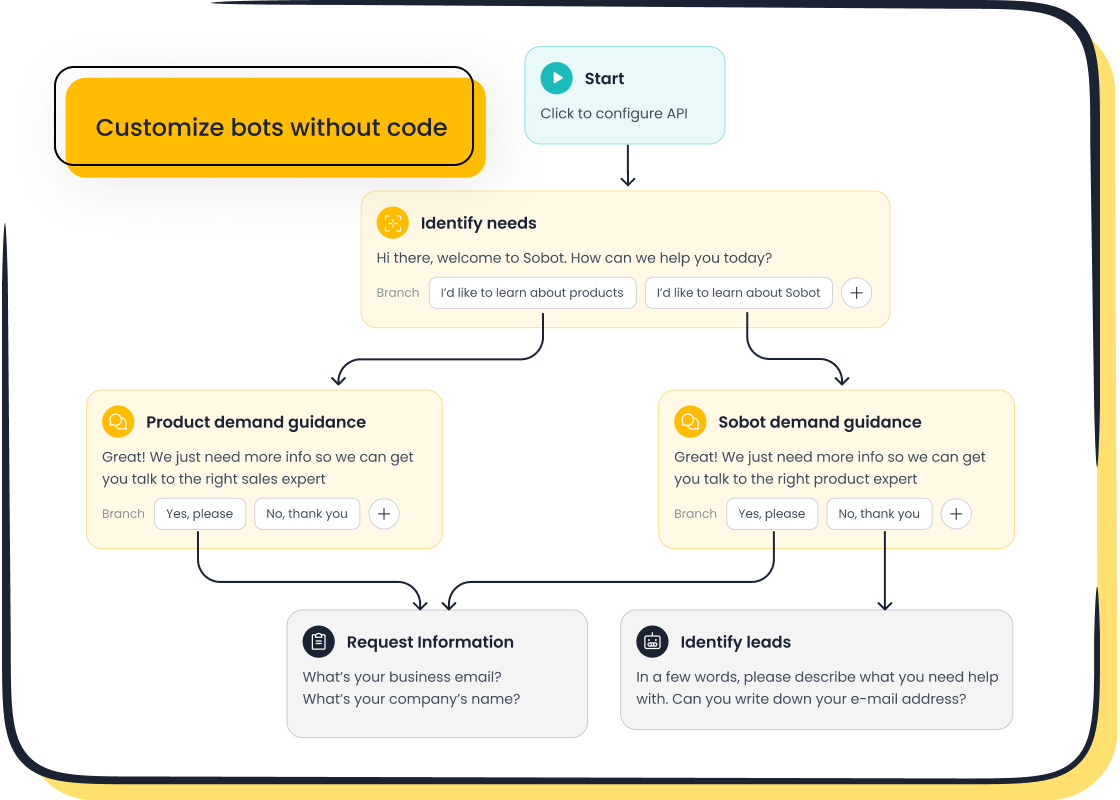
The effectiveness of chatbots in this area is evident through metrics like Goal Completion Rate (GCR) and Resolution Rate. A high GCR indicates that users successfully complete tasks like scheduling appointments, while a strong Resolution Rate reflects the chatbot’s ability to manage queries independently. These metrics demonstrate how chatbots enhance efficiency and improve customer service.
For example, a customer looking to book a consultation can interact with Sobot’s chatbot to find available slots and confirm the appointment instantly. This automation reduces wait times and eliminates errors, ensuring a smooth experience. Businesses using chatbots for scheduling report higher customer satisfaction and operational efficiency. By leveraging AI, you can optimize this process and provide a hassle-free experience for your customers.
Actionable Strategies for Implementing Chatbots
Setting Clear Objectives for Chatbot Deployment
Before deploying chatbots, you must define their purpose and align their goals with your business strategy. A clear roadmap ensures the chatbot delivers measurable results and enhances customer service. Start by identifying the primary role of the chatbot. Will it handle customer support, drive sales, or assist with lead generation? Once you establish its role, outline specific objectives. For instance, aim to improve response times or increase customer self-service rates.
Tip: Set performance benchmarks to measure success. For example, track metrics like resolution time, customer satisfaction scores, or the percentage of queries resolved without human intervention.
Additionally, ensure the chatbot contributes to broader business goals. If your objective is to boost customer retention, design the chatbot to provide personalized recommendations or proactive support. By setting clear objectives, you create a foundation for a successful chatbot deployment that aligns with your business needs.
Integrating Chatbots with Omnichannel Platforms
Integrating chatbots with omnichannel platforms ensures seamless customer interactions across multiple touchpoints. Customers often switch between channels like email, social media, and live chat. A unified chatbot system maintains consistency, improving the overall experience. For example, Sobot’s chatbot integrates with platforms like WhatsApp and SMS, enabling you to deliver personalized support regardless of the channel.
Businesses that adopt omnichannel integration report significant benefits:
- 75% Reduction in First-Level Tickets: Routine queries are resolved instantly, freeing up support teams for high-impact conversations.
- Enhanced User Satisfaction: Organizations observed a 35% rise in CSAT (Customer Satisfaction Score) within three months.
- Operational Savings: Companies saved up to 40% in customer support costs by reducing dependency on manual agents.
- Speed of Resolution: Average response time dropped from 18 minutes to under 1 minute.
By integrating chatbots with omnichannel platforms, you can automate up to 86% of queries, allowing your team to focus on complex issues. This approach not only improves efficiency but also enhances customer satisfaction and retention.
Training Chatbots for Complex Query Handling
To handle complex queries effectively, chatbots require advanced training. AI-powered chatbots like Sobot’s use natural language processing (NLP) to understand customer intent and provide accurate responses. Techniques like entity recognition and sentiment analysis enable chatbots to manage multi-turn dialogues and deliver meaningful solutions.
Machine learning plays a crucial role in refining chatbot performance. Methods such as supervised learning and reinforcement learning help chatbots adapt to new scenarios and improve over time. For example, Sobot’s chatbot continuously learns from user interactions, enhancing its ability to address industry-specific queries.
Note: Incorporating domain expertise ensures the chatbot can handle specialized inquiries. For instance, in the e-commerce sector, a chatbot trained on product catalogs and customer preferences can provide tailored recommendations.
Continuous feedback is essential for improving chatbot accuracy. Encourage customers to rate their interactions and use this data to refine the chatbot’s knowledge base. By investing in training and optimization, you can ensure your chatbot delivers exceptional customer service and handles even the most complex queries with ease.
Monitoring Performance and Optimizing Interactions
Monitoring chatbot performance is essential to ensure it delivers consistent and effective customer service. By tracking key metrics, you can identify areas for improvement and optimize interactions to enhance the overall customer experience. Advanced analytics platforms, such as those offered by Talkative, provide valuable insights into chatbot performance. These tools allow you to monitor knowledge base response rates, customer satisfaction (CSAT) scores, and abandonment rates.
To assess your chatbot’s effectiveness, focus on the following metrics:
- Confusion Rate: Measures how often the chatbot fails to understand user intent.
- Resolution Rate: Indicates the percentage of queries resolved without human intervention.
- Feedback Score: Aggregates customer evaluations of the chatbot’s accuracy and utility.
Incorporating robust monitoring frameworks ensures your chatbot remains efficient and reliable. For example, Sobot’s AI-powered chatbot includes analytics dashboards that visualize key metrics like engagement rates, response times, and error rates. These dashboards help you identify trends and refine the chatbot’s responses. Additionally, features like logging and tracing capture detailed conversation logs, enabling you to diagnose issues and improve performance.
Optimizing interactions involves more than just monitoring metrics. You should also leverage external evaluation pipelines and automated model-based assessments to evaluate the quality of chatbot responses. For instance, Sobot’s chatbot uses AI to analyze user behavior and refine its knowledge base. This continuous optimization ensures the chatbot adapts to evolving customer needs, providing accurate and personalized support across all channels.
By actively monitoring and optimizing your chatbot, you can improve resolution rates, reduce confusion, and enhance customer satisfaction. This proactive approach not only boosts operational efficiency but also strengthens your brand’s reputation for delivering exceptional customer service.
Leveraging Customer Feedback for Continuous Improvement
Customer feedback is a powerful tool for refining chatbot functionality and improving service quality. By analyzing feedback, you can identify underperforming areas and implement changes that enhance the chatbot’s effectiveness. Metrics like Net Promoter Score (NPS) and CSAT provide valuable insights into customer satisfaction and the overall success of your chatbot.
Consider these feedback-driven strategies for continuous improvement:
- Allow customers to rate specific chatbot messages. This helps pinpoint responses that need refinement.
- Regularly analyze satisfaction metrics, such as first-contact resolution rates, to identify trends and areas for growth.
- Continuously update the chatbot’s responses based on user feedback to address evolving customer needs.
For example, Sobot’s chatbot integrates feedback mechanisms directly into its interface, enabling customers to provide real-time evaluations. This data helps refine the chatbot’s knowledge base and improve its ability to handle complex queries. Additionally, Sobot’s AI capabilities allow businesses to add new features and functionalities, ensuring the chatbot remains relevant and effective.
Feedback not only improves chatbot performance but also enhances the customer experience. Customers feel valued when their input leads to tangible improvements, fostering trust and loyalty. By leveraging feedback effectively, you can create a chatbot that evolves alongside your business and consistently meets customer expectations.
Choosing the Right Chatbot for Your Business
Assessing Business Needs and Customer Expectations
Selecting the right chatbot begins with understanding your business needs and what your customers expect. Start by defining specific goals for the chatbot. For example, do you want it to handle FAQs, provide personalized recommendations, or assist with order tracking? Once you identify its purpose, evaluate its performance using measurable metrics like response time, accuracy, and user satisfaction.
To simplify this process, consider the following criteria:
| Criteria | Description |
|---|---|
| Specific | Define specific objectives for the chatbot, such as handling certain types of queries. |
| Measurable | Assess performance using metrics like response time, accuracy, and user satisfaction. |
| Achievable | Consider the feasibility of meeting user expectations. |
| Relevant | Ensure responses align with user queries and customer service strategy. |
| Time-bound | Assess responsiveness in handling queries within a reasonable time frame. |
Additionally, evaluate the chatbot's functionality, usability, and reliability. For instance, Sobot’s chatbot excels in these areas by offering 24/7 availability, multilingual support, and seamless integration with omnichannel platforms. These features ensure it meets customer expectations while enhancing their experience.
Comparing AI-Powered vs. Rule-Based Chatbots
Understanding the differences between AI-powered and rule-based chatbots helps you choose the right one for your business. Rule-based chatbots follow predefined scripts, making them suitable for simple, repetitive tasks. In contrast, AI-powered chatbots use machine learning to understand context, adapt to diverse queries, and improve over time.
| Category | Rule-Based Chatbots | AI-Powered Chatbots |
|---|---|---|
| Performance & Capabilities | Consistent, reliable for repetitive tasks; limited context understanding. | Understands context, adapts with machine learning, handles diverse queries. |
| Cost | Lower initial investment and maintenance; suitable for small businesses. | Higher setup and maintenance costs; scalable and justified for complex needs. |
| Implementation | Quick setup, minimal technical effort, limited customization. | Longer deployment, requires expertise, highly customizable. |
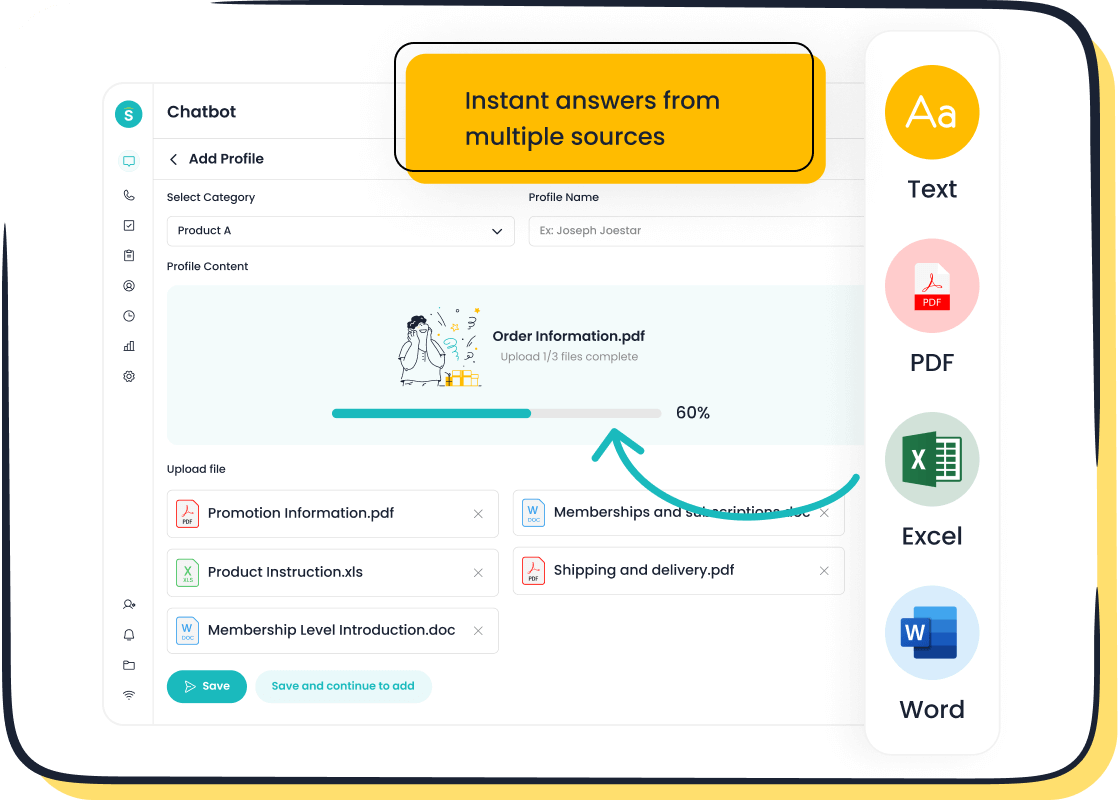
For example, Sobot’s AI-powered chatbot uses advanced natural language understanding (NLU) to deliver human-like interactions. It can maintain free-flowing conversations, continuously learn from interactions, and adapt to complex customer service scenarios. This makes it an ideal choice for businesses aiming to provide personalized and efficient customer support.
Evaluating Integration Capabilities with Existing Systems
A chatbot’s ability to integrate with your existing systems significantly impacts its effectiveness. Seamless integration ensures the chatbot can access real-time data, automate routine tasks, and enhance operational efficiency. For instance, chatbots can notify suppliers when inventory levels are low, preventing supply chain disruptions. They can also automate order tracking, reducing manual effort and improving customer satisfaction.
Sobot’s chatbot stands out with its robust integration capabilities. It connects effortlessly with platforms like WhatsApp, SMS, and e-commerce systems, enabling you to deliver consistent customer service across channels. By automating tasks and providing data-driven insights, it helps businesses navigate complexities with precision and agility. This integration not only reduces costs but also transforms how you manage customer interactions.
Considering Scalability and Future Growth
When selecting chatbots for your business, scalability and future growth should be top priorities. As your customer base expands, the chatbot must handle increasing query volumes without compromising performance. A scalable chatbot ensures consistent customer service, even during peak periods or as your business grows.
To evaluate scalability, focus on performance metrics and benchmarks. For example:
| Metric Type | Description |
|---|---|
| Adversarial Testing | Assesses robustness by evaluating the chatbot under intentional input distortions. |
| OOD Testing | Tests how well the chatbot performs on data outside its training distribution. |
| Human-in-the-Loop Evaluation | Combines automated metrics with human judgment for qualitative assessments. |
| Hybrid Approaches | Balances scalability and depth by merging static and dynamic evaluations. |
| Real-World Testing | Simulates practical applications using domain-specific datasets. |
Additionally, consider factors like confounding variables, prompt techniques, and evaluation tools. These elements ensure the chatbot adapts to diverse user needs and business scenarios. For instance, Sobot’s AI-powered chatbot excels in scalability by processing up to 30 requests per second while maintaining 100% uptime during peak hours. This capability ensures uninterrupted customer interactions, even as your business scales.
By choosing a chatbot designed for growth, you future-proof your customer service strategy. This approach not only enhances customer satisfaction but also positions your business for long-term success.
Testing User Experience Before Full Deployment
Testing the chatbot’s user experience is essential before launching it fully. This step ensures the chatbot meets customer expectations and delivers accurate, helpful responses. Usability testing, for instance, evaluates the chatbot’s interface and interaction flow by observing real users.
| Aspect | Description |
|---|---|
| Enhanced User Experience | Ensures the chatbot understands user inputs correctly and provides accurate responses. |
| Usability Testing | Evaluates the chatbot's user interface and interaction flow by observing real users. |
| User Feedback | Highlights areas needing improvement based on real-world user interactions. |
Remote user testing plays a crucial role in identifying pain points. It reveals why users might abandon interactions, helping you address critical issues. Even minor errors can erode trust in the chatbot. For example, Sobot’s chatbot incorporates user feedback mechanisms to refine its responses and improve usability. This iterative process ensures the chatbot evolves to meet customer needs effectively.
By prioritizing user testing, you can launch a chatbot that enhances customer satisfaction and builds trust. This proactive approach ensures your chatbot delivers a seamless and engaging experience from day one.
Sobot's Chatbot: A Game-Changer for Customer Experience
Key Features of Sobot's Chatbot
Sobot's chatbot stands out with its advanced capabilities and user-friendly design. You can deploy it effortlessly without any coding skills, thanks to its intuitive point-and-click interface. This ease of deployment ensures that businesses of all sizes can quickly integrate the chatbot into their operations. Additionally, Sobot provides professional training support, helping you maximize the chatbot's potential.
The chatbot leverages self-developed natural language processing (NLP) and advanced large language models (LLMs). These technologies enable it to understand customer intent accurately and learn from unknown queries. With omnichannel support, the chatbot interacts seamlessly across platforms like WhatsApp, SMS, and live chat. Its multilingual capabilities ensure effective communication with diverse customer bases, enhancing inclusivity and accessibility.
| Feature/Benefit | Description |
|---|---|
| Ease of Deployment | Sobot's Chatbot is designed to be out of the box, requiring no coding skills for setup. |
| Training Support | Professional technical teams assist businesses in training the Chatbot effectively. |
| Advanced Capabilities | Utilizes self-developed NLP and advanced LLM to improve accuracy and learn from unknown queries. |
Benefits of Using Sobot's Chatbot for Customer Service
Sobot's chatbot transforms how you manage customer interactions. It operates 24/7, ensuring no query goes unanswered, even during peak hours or holidays. By automating routine tasks, it reduces operational costs by up to 50% and improves productivity by 70%. This allows your team to focus on complex issues, enhancing overall efficiency.
The chatbot also personalizes customer interactions using AI-driven insights. It analyzes data like purchase history and preferences to deliver tailored recommendations. This personalization boosts customer satisfaction and drives sales. Businesses using Sobot's chatbot report a 20% increase in conversions and a 30% improvement in lead generation.
Moreover, the chatbot ensures consistent communication across channels. Whether customers reach out via email, social media, or live chat, they receive the same high-quality support. This consistency builds trust and strengthens your brand reputation.
Real-World Success Stories: OPPO's Transformation
OPPO, a global leader in smart devices, partnered with Sobot to revolutionize its customer service. During peak shopping periods, OPPO faced challenges managing high inquiry volumes. By implementing Sobot's chatbot, the company automated repetitive queries, allowing human agents to focus on complex issues. This human-machine collaboration improved efficiency and reduced response times.
Sobot also optimized OPPO's knowledge base, cutting maintenance efforts by 90%. The chatbot achieved an impressive 83% resolution rate and a 94% positive feedback rate. These improvements contributed to a 57% increase in OPPO's repurchase rate. By integrating global customer channels, OPPO enhanced data accessibility and service quality, setting a new standard for customer experience.
How Sobot's Chatbot Enhances Operational Efficiency
Sobot's chatbot revolutionizes operational efficiency by automating repetitive tasks and streamlining workflows. It integrates seamlessly with various channels and internal systems, ensuring smooth communication across platforms like WhatsApp, SMS, and live chat. This integration eliminates data silos, allowing your team to access customer information instantly and respond faster.
The chatbot also provides easy access to performance statistics, enabling you to monitor over 300 key metrics. These insights help you identify bottlenecks and implement targeted improvements. For example, you can track agent efficiency, which increases by 30% after deploying Sobot's chatbot. Additionally, customer satisfaction scores often reach an impressive 97%, reflecting the enhanced service quality.
| Metric | Value |
|---|---|
| Agent Efficiency | 30% |
| Customer Satisfaction | 97% |
Sobot's chatbot supports data analysis, offering actionable insights to optimize operations. It uses AI to analyze customer interactions, helping you refine workflows and improve service delivery. By automating routine queries, the chatbot reduces agent workload, allowing them to focus on complex issues. This division of labor not only boosts productivity but also enhances the overall customer experience.
Tip: Use the chatbot's analytics dashboard to monitor trends and refine your strategies. This proactive approach ensures continuous improvement and long-term success.
Steps to Get Started with Sobot's Chatbot
Getting started with Sobot's chatbot is straightforward and requires no coding expertise. Follow these steps to integrate it into your operations:
-
Define Your Objectives: Identify the primary goals for the chatbot. Whether you aim to automate FAQs, provide personalized recommendations, or enhance customer support, having clear objectives ensures a focused implementation.
-
Set Up the Chatbot: Use Sobot's intuitive point-and-click interface to design workflows. The platform simplifies the setup process, allowing you to deploy the chatbot quickly.
-
Train the Chatbot: Upload your knowledge base, including FAQs, product details, and customer preferences. Sobot's AI capabilities enable the chatbot to learn from this data and deliver accurate responses.
-
Integrate with Channels: Connect the chatbot to your preferred platforms, such as WhatsApp, SMS, or live chat. This ensures consistent communication across all customer touchpoints.
-
Monitor and Optimize: Use the analytics dashboard to track performance metrics like resolution rates and customer satisfaction. Regularly update the chatbot's knowledge base to keep it aligned with evolving customer needs.
By following these steps, you can deploy Sobot's chatbot effectively and start reaping the benefits of improved efficiency and customer satisfaction.
Chatbots have revolutionized customer service by saving businesses up to 2.5 billion hours annually and automating 80% of routine inquiries. Their ability to enhance efficiency, reduce costs, and deliver personalized experiences makes them indispensable.
| Statistic Description | Value |
|---|---|
| Predicted time savings for businesses | Up to 2.5 billion hours by 2024 |
| Ability to manage routine tasks | Up to 80% of inquiries |
| Business leaders prioritizing AI expansion | 72% of leaders |
Strategic implementation and continuous monitoring are vital for success. You should track metrics like query resolution rates, customer sentiment, and fallback rates to refine chatbot performance. Regular reviews ensure the chatbot evolves with customer needs.
Sobot's Chatbot offers a seamless way to enhance customer interactions. Its AI-driven insights and omnichannel support create consistent, personalized experiences. By leveraging customer feedback, you can ensure your chatbot remains effective and aligned with expectations. Explore Sobot today to transform your customer experience.
FAQ
What are the main benefits of using chatbots for customer service?
Chatbots improve customer service by offering 24/7 support, reducing response times, and automating routine tasks. They save up to 30% on operational costs and boost productivity by 70%. Sobot’s AI-powered chatbot enhances customer experience with personalized interactions and seamless omnichannel communication. Learn more here.
Can chatbots handle complex customer queries?
Yes, AI-powered chatbots like Sobot’s use advanced natural language processing (NLP) to understand customer intent. They manage multi-turn conversations and adapt to complex scenarios. For example, Sobot’s chatbot resolves 83% of inquiries independently, freeing agents to focus on critical issues.
How do chatbots personalize customer interactions?
Chatbots analyze customer data, such as purchase history and preferences, to deliver tailored recommendations. Sobot’s chatbot uses AI-driven insights to create meaningful interactions across platforms like WhatsApp and SMS. Businesses report a 20% increase in conversions with personalized chatbot support.
Are chatbots suitable for multilingual customer communication?
Absolutely! Sobot’s chatbot supports multiple languages, ensuring effective communication with diverse audiences. It uses AI to understand cultural nuances and deliver accurate responses. Multilingual chatbots improve customer satisfaction and engagement, especially for global businesses.
How can I integrate Sobot’s chatbot into my business?
Sobot’s chatbot offers a no-code setup with a point-and-click interface. You can define objectives, upload your knowledge base, and connect it to platforms like WhatsApp or live chat. Use its analytics dashboard to monitor performance and optimize interactions. Start here.
See Also
Enhancing Customer Satisfaction Through E-commerce Chatbots
Tips for Selecting the Ideal Chatbot Software
Simple Steps to Implement Chatbots on Your Website
